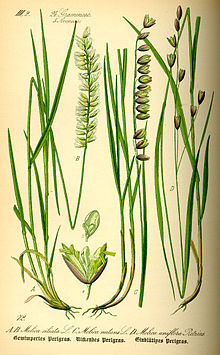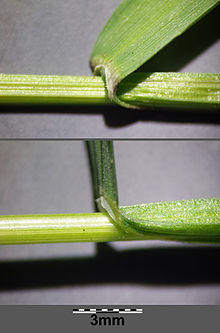Nodding pearl grass
| Nodding pearl grass | ||||||||||||
|---|---|---|---|---|---|---|---|---|---|---|---|---|
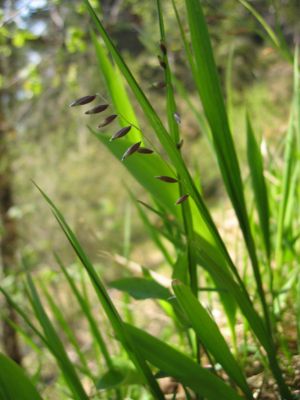
Nodding pearl grass ( Melica nutans ) |
||||||||||||
| Systematics | ||||||||||||
|
||||||||||||
| Scientific name | ||||||||||||
| Melica nutans | ||||||||||||
| L. |
The nodding melic ( Melica nutans ) is a kind of the genus of melica ( Melica ) within the family of grasses (Poaceae). The species is widespread in Eurasia .
etymology
The German trivial name "Perlgras" refers to the spherical to egg-shaped, mostly dark, shiny spikelets that appear strung like pearls on a string. There are regional trivial names that also refer to the typical appearance of the inflorescences such as "Saulaus" in Austria or "Geisszötteli" or "Galläseckeli" in Switzerland.
description
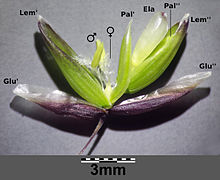
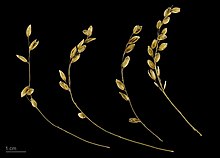
Vegetative characteristics
The nodding pearl grass grows as a deciduous, perennial, herbaceous plant and reaches heights of 30 to 60 centimeters. The loose lawn-forming species has a thin, long creeping basic axis, sometimes with runners . The leaves are divided into leaf sheath and leaf blade. Of the upwardly rough, more or less winged to keeled leaf sheaths , the lower ones are mostly purple in color. The brownish ligule is relatively short with a length of about 0.5 millimeters. The light green leaf blade is about 4 millimeters wide and mostly hairy at the top.
Generative characteristics
The flowering period extends from May to July. The einseitswendige, down a steep weak traubige , panicles inflorescence is hardly up to 10 centimeters long. The short-stalked, nodding two-flowered spikelets are 6 to 7 millimeters long and obovate and shiny purple to brown-purple, sometimes a little green or whitish piebald. There is a 5 to 7 mm long, piston-shaped, stunted remnant of the flower. Awns are missing. The lemmas are glabrous and the glumes are brown-purple.
The number of chromosomes is 2n = 18, based on the base number of the genus Melica of x = 9, diploidy is present.
Occurrence
The nodding pearl grass is common in the temperate zones of Eurasia. In Austria , the nodding pearl grass is common in all federal states, especially in the colline altitude range . In Germany this species occurs scattered in the north and is common in the south. In the Allgäu Alps in Bavaria on the Gängele north-east of Oberstdorf it rises to 1820 m above sea level.
The nodding pearl grass likes to grow on limestone and like to colonize the north side ("penumbral grass") in clear areas in forests. It thrives best on warm, moderately moist, nutrient-rich soils with a slightly acidic humus layer, but also on block heaps (stone soils).
The Nodding melic is characteristic species of the class of noble hardwood forests ( Querco-Fagetea ). Other main occurrences are in the class Vaccinio-Piceetea and the class Erico-Pinetea.
ecology
The nodding pearl grass is a rhizome - geophyte or hemicryptophyte . Vegetative propagation occurs through the several decimeter long runners . It has roots up to 50 centimeters deep.
In terms of flower ecology, it is wind flowering of the "long-dust thread type".
Diaspores (unit of spread) are the caryopses loosely covered by the shiny husks . At maturity the upper caryopses fall out first; later the lowest caryopsis together with the glumes of the spikelet is blown away as a balloon flyer. The caryopses that fell out first are subject to the spread of ants . The fruit ripens from June to July, with the lowest flower until October.
literature
- Manfred A. Fischer, Wolfgang Adler, Karl Oswald: Excursion flora for Austria, Liechtenstein and South Tyrol . 2nd, improved and enlarged edition. Province of Upper Austria, Biology Center of the Upper Austrian State Museums, Linz 2005, ISBN 3-85474-140-5 , p. 1158 .
- Hans Joachim Conert: Parey's grass book. Recognize and determine the grasses of Germany . Parey, Berlin 2000, ISBN 3-8263-3327-6 , pp. 402 .
- Jürke Grau , Bruno P. Kremer, Bodo M. Möseler, Gerhard Rambold, Dagmar Triebel: Grasses. Sweet grasses, sour grasses, rushes and grass-like families in Europe (= Steinbach's natural guide ). New, edit. Special edition edition. Mosaik, Munich 1996, ISBN 3-576-10702-9 .
- Nodding pearl grass. In: FloraWeb.de. (Sections Description and Ecology)
Individual evidence
- ↑ a b c d e f g Nodding pearl grass. In: FloraWeb.de.
- ^ Mary E. Barkworth: Melica. In: Flora of North America Editorial Committee (Ed.): Flora of North America North of Mexico . Volume 24: Magnoliophyta: Commelinidae (in part): Poaceae (part 1) . Oxford University Press, New York / Oxford a. a. 2007, ISBN 978-0-19-531071-9 (English, [ http://herbarium.usu.edu/treatments/Melica.htm ( Memento of November 4, 2012 in the Internet Archive ) online]).
- ↑ Rafaël Govaerts (ed.): Melica nutans. In: World Checklist of Selected Plant Families (WCSP) - The Board of Trustees of the Royal Botanic Gardens, Kew . Retrieved November 6, 2016.
- ↑ Erhard Dörr, Wolfgang Lippert : Flora of the Allgäu and its surroundings. Volume 1, IHW, Eching 2001, ISBN 3-930167-50-6 , p. 183.
- ↑ a b Erich Oberdorfer : Plant-sociological excursion flora for Germany and neighboring areas . With the collaboration of Angelika Schwabe and Theo Müller. 8th, heavily revised and expanded edition. Eugen Ulmer, Stuttgart (Hohenheim) 2001, ISBN 3-8001-3131-5 , pp. 228-229 .
- ↑ a b c Ruprecht Düll , Herfried Kutzelnigg : Pocket dictionary of plants in Germany and neighboring countries. The most common Central European species in portrait . 7th, corrected and enlarged edition. Quelle & Meyer, Wiebelsheim 2011, ISBN 978-3-494-01424-1 .
Web links
- Nodding pearl grass. In: FloraWeb.de.
- Nodding pearl grass . In: BiolFlor, the database of biological-ecological characteristics of the flora of Germany.
- Profile and distribution map for Bavaria . In: Botanical Information Hub of Bavaria .
- Melica nutans L. In: Info Flora , the national data and information center for Swiss flora .
- Distribution in the northern hemisphere from: Eric Hultén, Magnus Fries: Atlas of North European vascular plants. 1986, ISBN 3-87429-263-0 at Den virtuella floran. (swed.)
- Thomas Meyer: Data sheet with identification key and photos at Flora-de: Flora von Deutschland (old name of the website: Flowers in Swabia )
